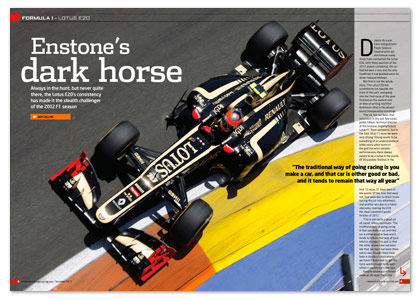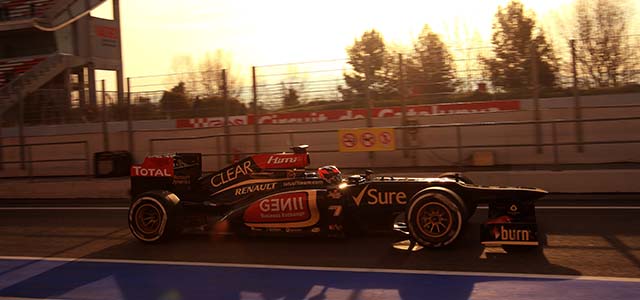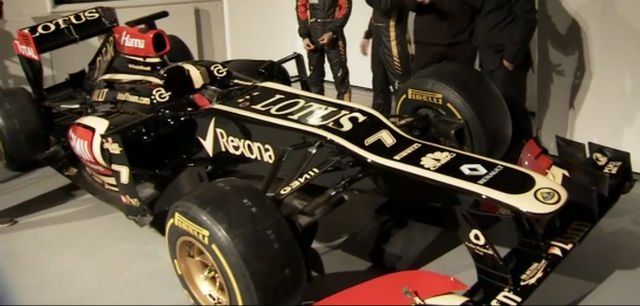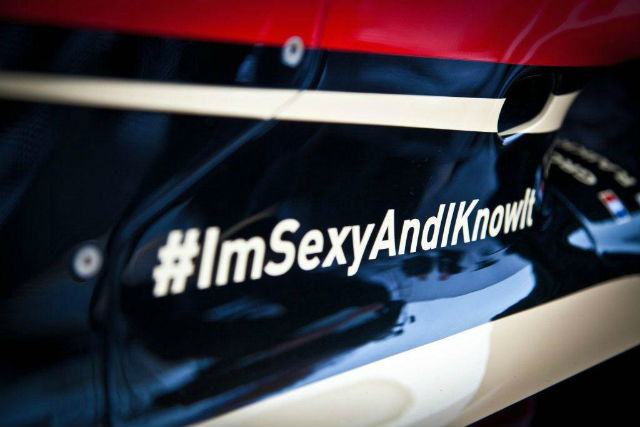
Lotus was the first team to show off its 2013 design albeit in digital form via a launch on Youtube. At the launch technical director James Allison said “The E20 proved itself to be an effective racing car – particularly towards the end of last season – so there is an element of expectation from the E21 and plenty to build upon. We have continued with our design themes and tried to create a more efficient and faster racing car based on all the lessons we learnt last year. How successful we have been in this task will only be discovered when we take to the track at the winter tests and – more significantly – at Grands Prix.”
Allison continues after being interrupted by a gallery; “depending on where you look, some parts of the new car are a ground-up redesign and in other areas we have further optimised the best bits of the design philosophy we’ve adopted for several seasons. The front and rear suspension layouts are substantially revised to try and give us better aerodynamic opportunities. The front wing is a continuation of the concepts we have worked on since the 2009 rules were published. For the rear wing system, we’ve continued to try to work on having a satisfactory level of rear downforce stability whilst having maximum DRS switching potential.”
There are a number of areas of the car which show off the current design trends in F1, it retains a humped nose despite a rule change allowing teams to fit a vanity cover to smooth the hump, it also appears to have an exhaust exit similar to that featured on last years Red Bull RB8.
It retains many features of the E20, which suggests that the launch car could actually be a E20 re painted and slightly modified, this was the approach the team too with the launch of the E20 last year with an updated R31. Interestingly the E20 part numbers all started R32 so it is possible that internally Lotus calls the car the R33.
Watch the launch again below
Allison revealed that even the very low weight of the vanity panel was enough to stop it being fitted to the car. Adding weight fairly high up and forwards in the design may not be ideal in terms of weight distribution despite the fact that the cover would only weigh a few grams.
One thing apparent on the launch car is Sauber style flow conditioners or ‘pod wings’ later utilised by Red Bull. It is thought that these little winglets have a lot to do with the airflow around the rear of the car especially around the exhaust exit and diffuser.
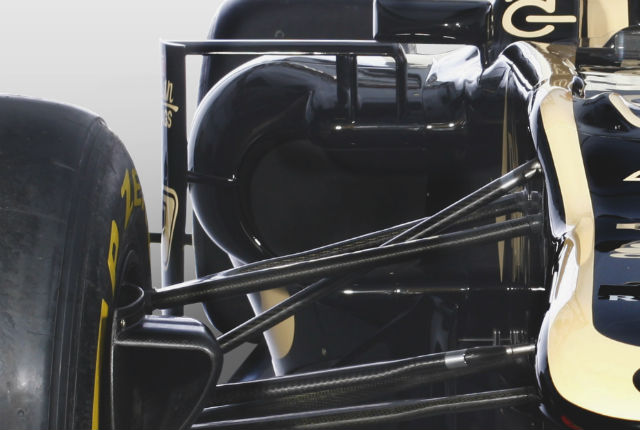
The exhaust location of the car is crucial and it appears that Lotus has followed the Sauber (and later Red Bull) lead. The exhaust gasses exit from a bulge at the rear of the sidepod and the Coanda effect (in theory) draws it down to the edge of the floor in the inner face of the rear tyre. If it works properly the flow then seals off the diffuser from a vortex generated by the rotating tyre, of the vortex enters the diffuser does not work as well and rear grip is lost. In effect this style of exhaust could be considered a ‘cold blow’ diffuser.
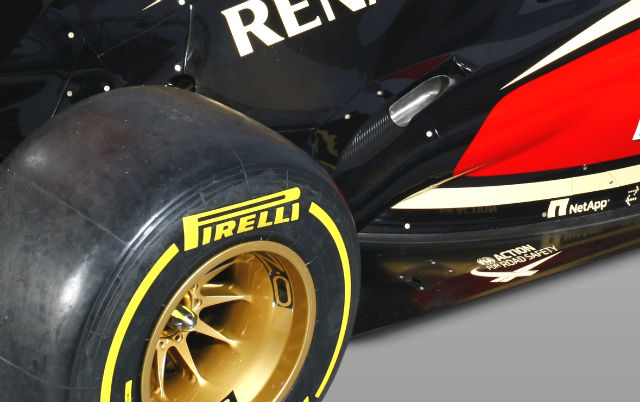
Also apparent in the high res studio images (below) are the odd bumps on the nose that James Allison refuses to explain. Note the lump on the right front (the left of this pic) is much larger than that on the left front. Usually you would expect to find damper mounts in this area but they would almost always be symmetrical.
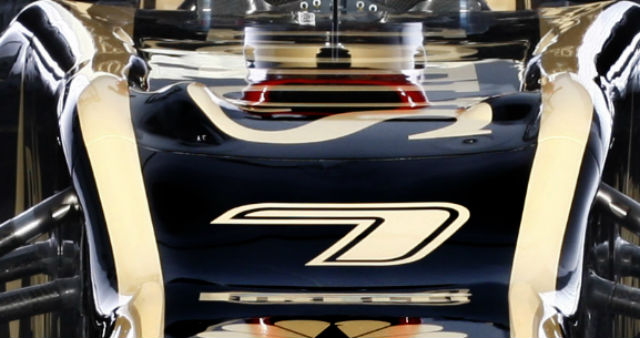
On the renderings of the E21 issued at the launch the car features the tell tale twin roll hoop intakes which are used for ‘the device’ or the Lotus interpretation of the “Double DRS” wing stalling device (below).
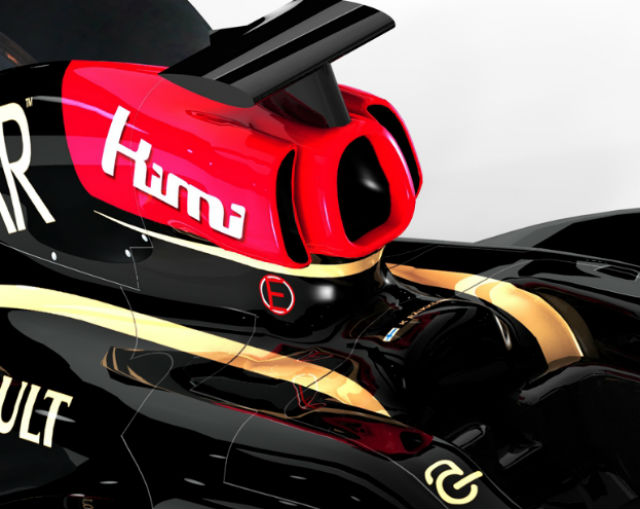
Interestingly the roll hoop of the launch car did not feature these ducts suggesting that perhaps the team is not certain about implementing ‘the device’ too early. “This is an area we continue to work on and the passive nature of the switching of our device means it is not outlawed by the latest regulations. It is not something which will be a silver bullet to transform our car, but it is something which could add performance as part of the overall design” Allison explains.”
TEST 01: JEREZ
Chassis: E21-01
With the launch of the E21 online only the first real chance to get a good look at the Lotus came at the first test. Instantly obvious were a number of updates fitted to the car since the launch.
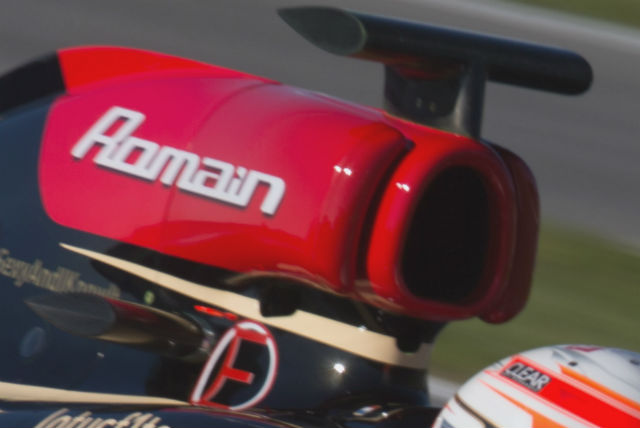
The roll hoop ears seen on the renderings above appeared on the car, but are either blanked off or have a very strange shape. It its thought that these ears have something to do with the Lotus rear wing stalling ‘device’
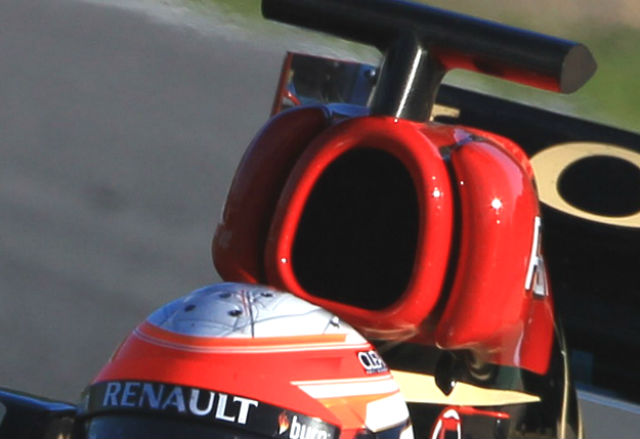
The diffuser on the E21 was visible in the pit lane during the test note the vented upper section.

Much flow vis running was conducted at Jerez, with the team studying the airflow over the modified parts.
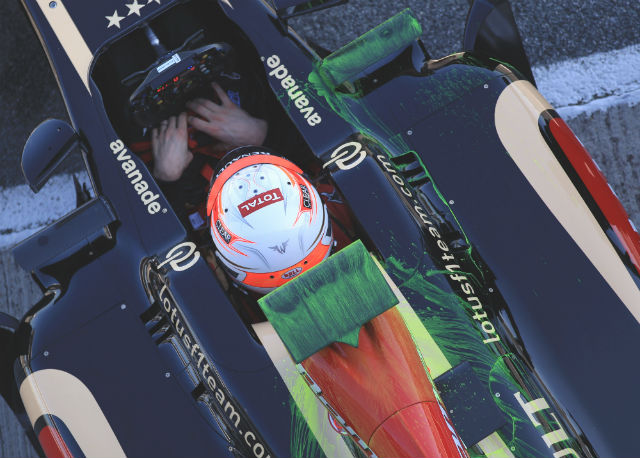
Note the new sidepod wings, these are very different to the ones fitted to the car at the launch, the application of flow visualisation dye shows that the Lotus team was studying their impact. Also note the cooling vents along the flank of the car. These are placed in one of the few areas of the cars body where openings are allowed under the current regulations.
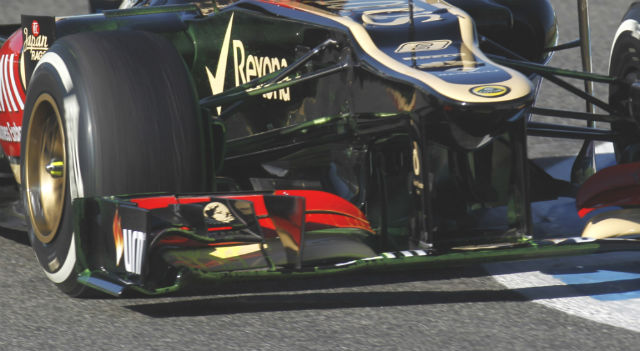
The front wing was also of interest to those wielding the dye bottle, note the dye that has collected on the suspension elements. A bulge under the E21’s nose is also clear in this image.
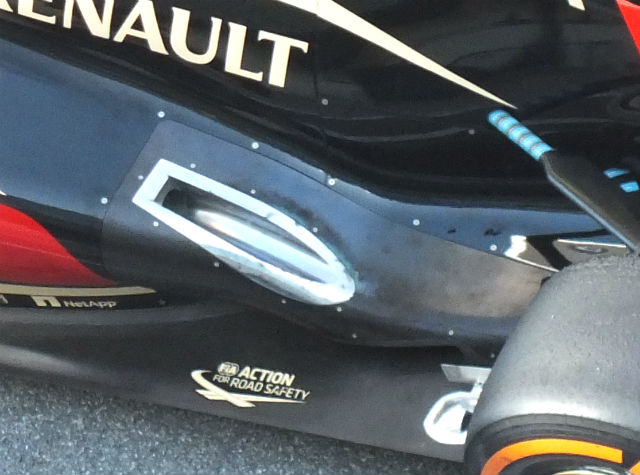
Lotus revised the E21’s exhaust on the third day of testing replacing the panel around the exhaust exit with a metal item (or at least one with a metallic coating). The overall design seems to remain the same so this may be as a result of burning bodywork still evident with the new design (above), also note the tunnel under the exhaust exit, a concept near identical to the Red Bull RB8 & RB9.
Compare the above with the layout run at the start of testing in Jerez (below)
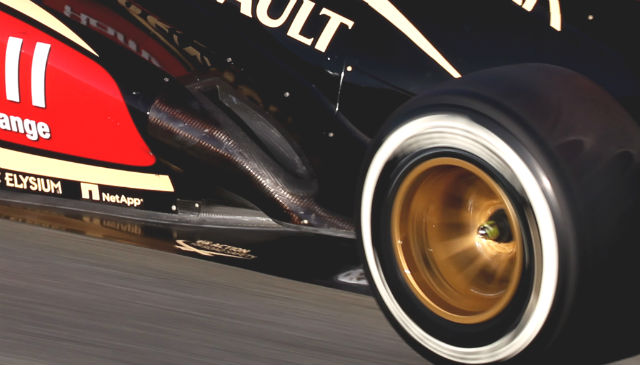
The stay holding the cars splitter (tea tray) is a fascinating design made of curved carbon fibre.
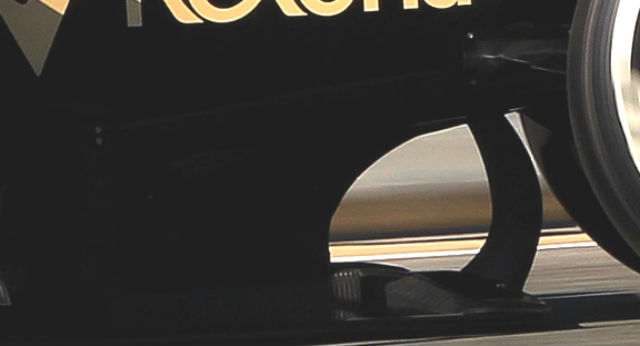
A small sensor array was run ahead of the rear wheels on the car.
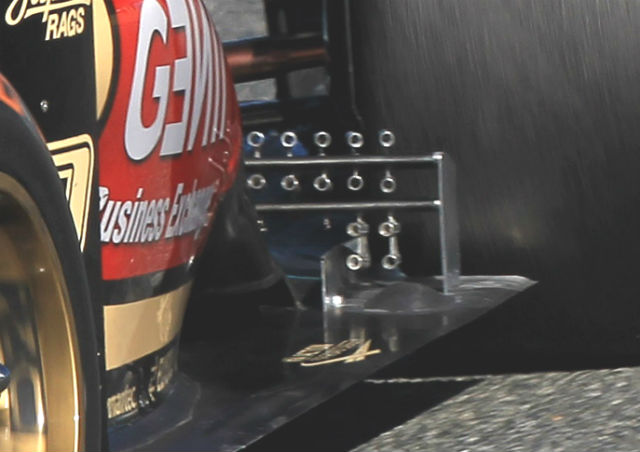
TEST 02: BARCELONA
Chassis: E21-02
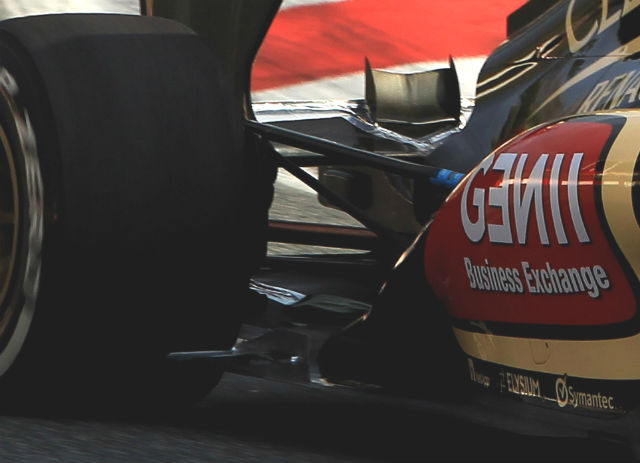
A look at the rear end of the Lotus, note the shape of the ‘monkey seat’ winglet. The car appears to be fitted with some temporary wiring shrouded in silver running out to the beam wing.
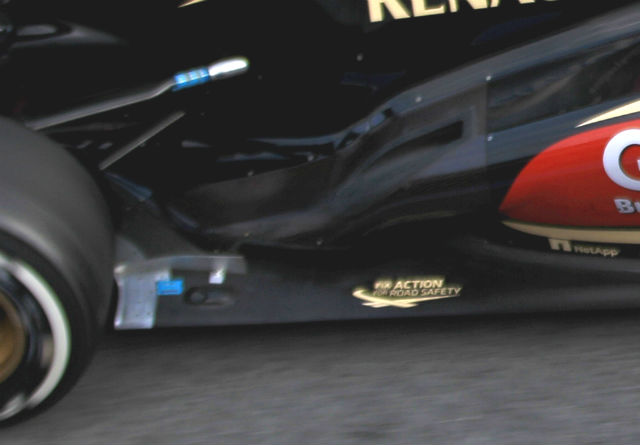
Lotus evaluated some new components at the rear of the floor, the parts can be seen here in silver. It also reverted to the original exhaust exit seen at Jerez.
At the test Lotus ran a new engine map which has not gone down well with the Governing body according to technical director James Allison. “During the final day of running at Barcelona last week we ran an experimental engine map and made the FIA fully aware of what we were doing. As it turned out they were not happy with what we had proposed and as a result we will not be using it at any of the races. As far as I’m concerned the situation was clear at the beginning and it’s clear now. It’s our responsibility as a team to stay within the rules, but at the same time to push the limits as far as possible; to do otherwise is to needlessly throw away performance. There are a set of rules governing engine maps and Renault have been exploring the boundaries of these in the same way as any other engine manufacturer.”
TEST 03: BARCELONA
Chassis: E21-02
“Pre-season testing was not perfect for us but we are confident in what we have seen from the E21. We had glitches and we didn’t complete as many laps as we wanted, yet we still completed most of the assessments we required and have a good platform heading to the first race of the season. It was good to see Kimi back in the car today to take over from Davide and Romain’s work yesterday. It’s certain going to be a highly competitive season but I’m confident that we’ll be right in the battle at the front.” – Eric Boullier, Team Principal.
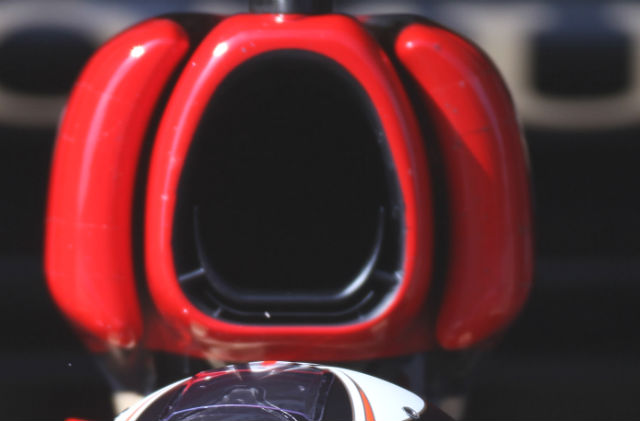
An interesting structure has appeared inside the roll hoop duct of the E21, it may have something to do with the fluidic switch related to the ‘ears’.
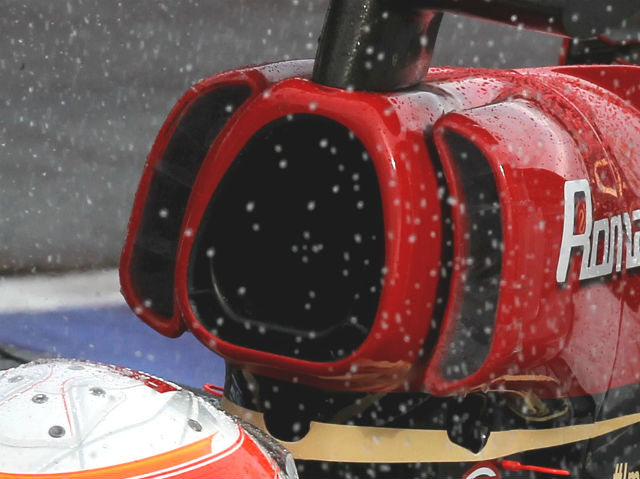
With the ears open what appear to be a number of segments can be seen inside the ducts.
“As everyone is aware, we experimented with this concept late last year but chose not to run with it outside of free practice. It is a fiercely complex system and to get it working correctly is certainly a challenge, but there are tantalising gains to be made should we achieve this. We conducted a bit of intermediate work with it at the last test and will be doing the same this week. However I don’t anticipate having it working at full capacity before the first race. We are expecting to be a good step closer by the time we leave Barcelona and hopefully we’ll see it make its full debut later in the year.” – James Allison
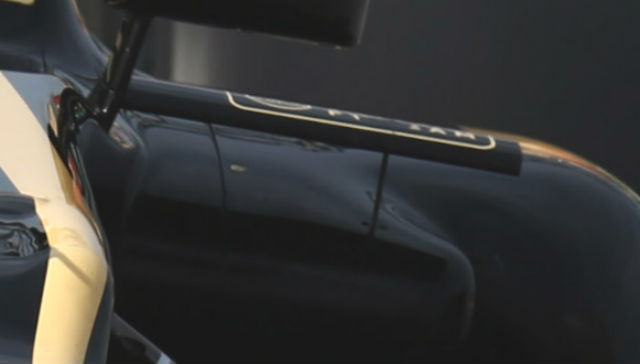
The pod wings on the E21 have gained a support towards the outer end, this suggests that the first iteration which did nor have a support may have flexed or fluttered at speed.
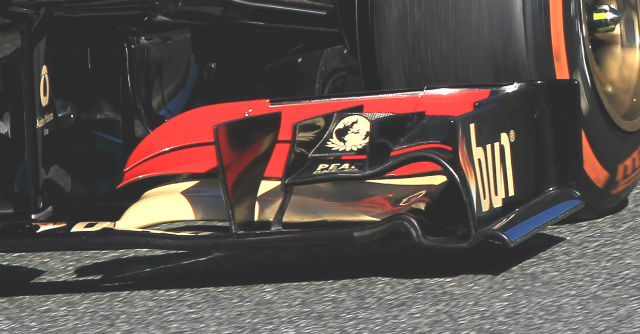
A new front wing was tested at Barcelona (above), with revised end plates and upper elements (and a new paint job it seems) compare the two versions above and below.
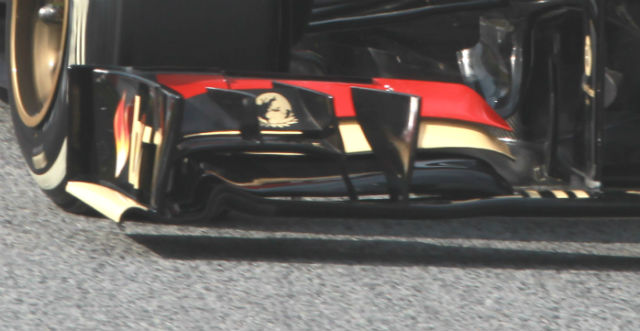 Lotus ran three evolutions of the ‘monkey seat’ winglet in preseason testing. The first ran in Jerez with a simple raised section in the centre of the wing (and can be seen in the Jerez report on this page).
Lotus ran three evolutions of the ‘monkey seat’ winglet in preseason testing. The first ran in Jerez with a simple raised section in the centre of the wing (and can be seen in the Jerez report on this page).
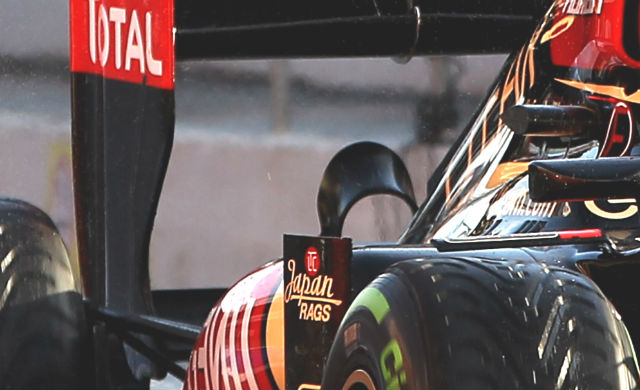
The next evolution featured a very curved winglet, sometimes used in conjunction with the wing stalling device.
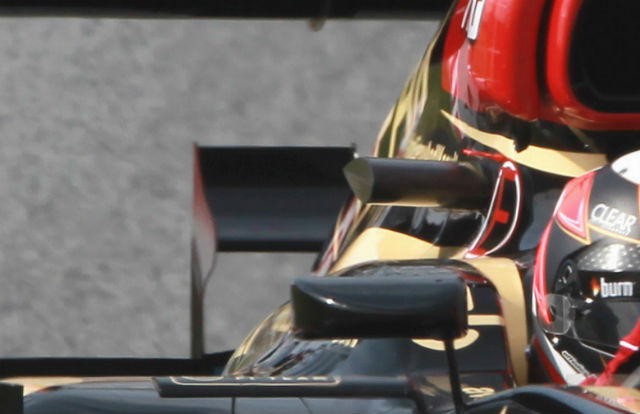
Finally a more conventional rectangular winglet was tested on the final day at Barcelona.
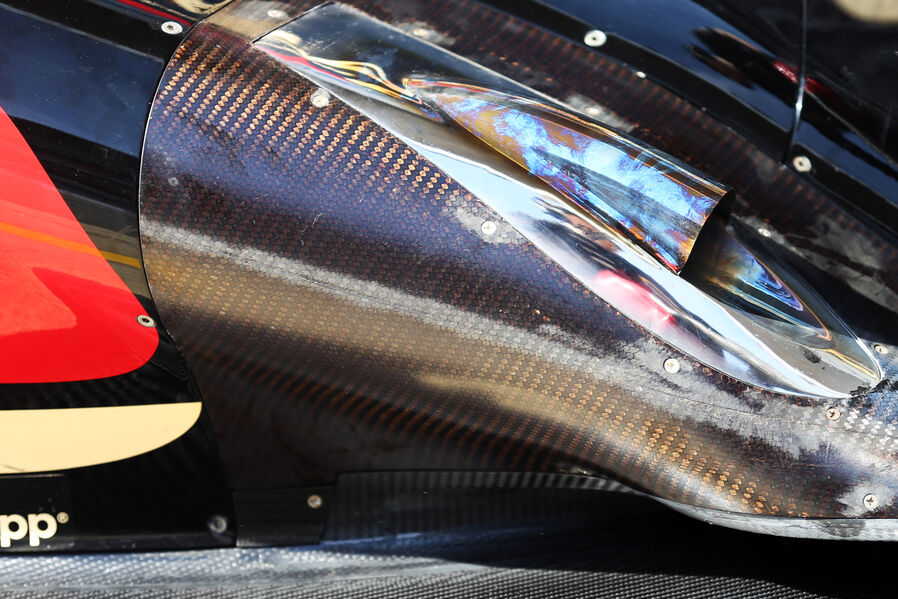
Despite being one of the first teams to call foul over the Caterham CT03 exhausts Lotus tested a solution that will have many rivals pouring over the regulations. But it seems that the design will not be run in competition as the team claimed that this design was simply for the purposes of running an aero test and that it would not be raced.
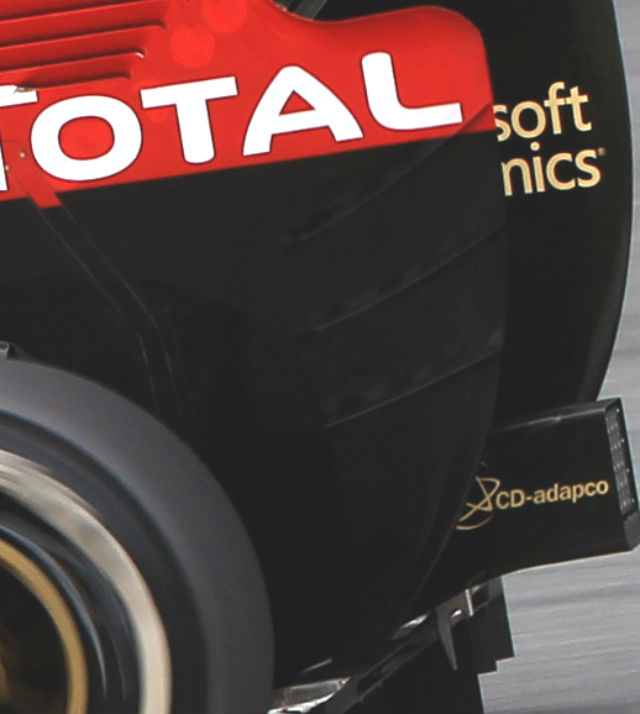
The rear wing end plate has been fitted with three strakes to manage the flow in this area
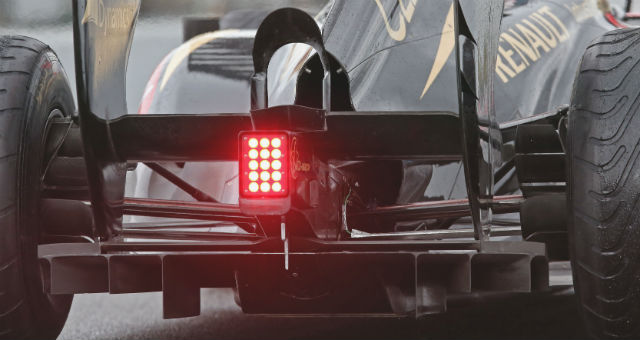
RACE 01: ALBERT PARK, MELBOURNE, AUSTRALIA
Car: 07
Chassis: E21-03
Result: 1st
Car: 08
Chassis: E21-01
Result: 10th
The driver of chassis 01 reported not feeling happy with the car, this has happened to Lotus before when the E20 suffered a chassis failure.

Lotus ran a revised front wing in Melbourne with the upper element of the forward and outboard section of the wing altered. The new version has a more less curved leading edge no longer mirroring the feature in the main plane. Compare the old version (below) with the new (above)
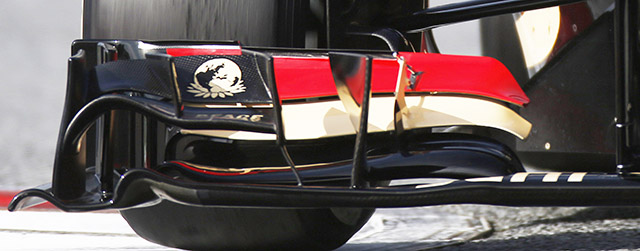
The base of the side pod mounted turning vane was also slightly revised for the race in Australia with a small winglet alongside it. It is likely that this part has some interaction with the flow structure from the revised front wing.

Compare the old version (below) with the new (above) also worth noting is the neat serrated bargeboard, not seen on any other cars (yet)
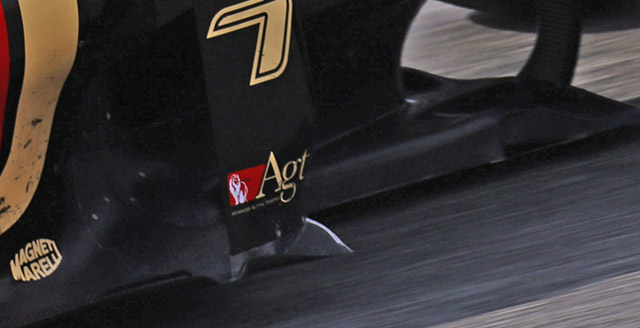
Another angle shows the wing profile of the new element at the base of the turning vane (below).
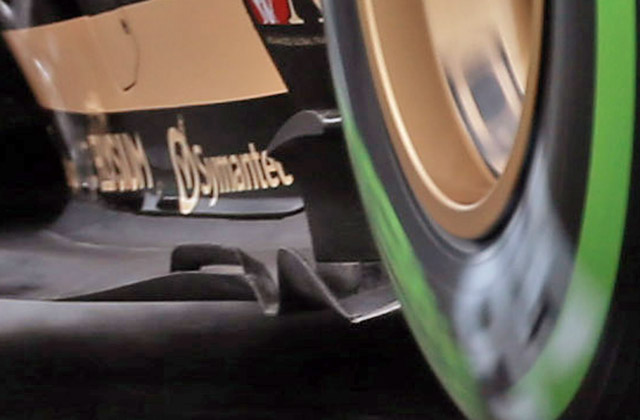
From behind it is clear to see that the slotted barge board, revised turning vane and winglet (as well as the little flick up on the floor) must all interact in the complex area. These details are likely a combination of CFD work and more accurate PIV sessions in the wind tunnel.
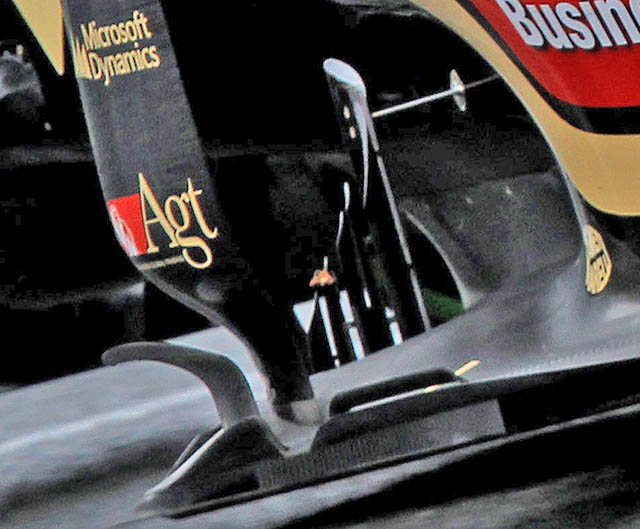
RACE 02: SEPANG, SELANGOR, MALAYSIA
Car: 07
Chassis: E21-03
Result: 7th
Car: 08
Chassis: E21-01
Result: 6th
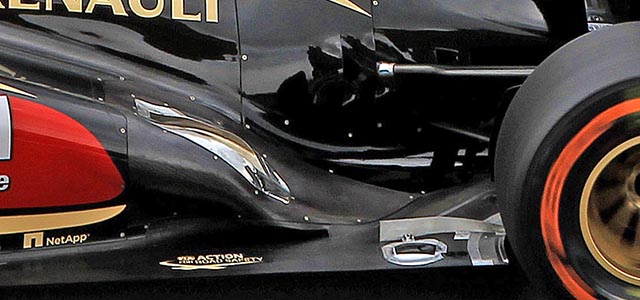
Lotus tried out a Red Bull style exhaust exit on one of the E21’s compare the new setup (above) with the old (below) run on the other car. A new Mercedes style cooling exit was also added where in forward mount of the upper wishbone is located. These updates were found to work well.
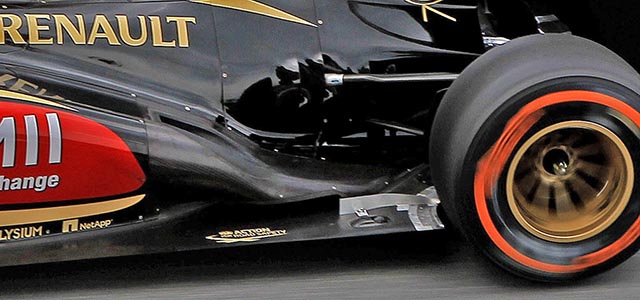
The diffuser was also revised slightly with a full width gurney (below)
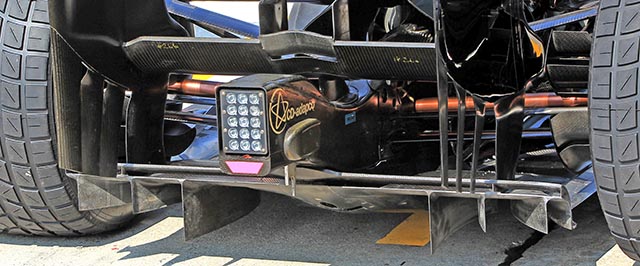
RACE 03: JIADING, SHANGHAI, CHINA
Car: 07
Chassis: E21-03
Result: 2nd
Car: 08
Chassis: E21-01
Result: 9th
Alan Permane, Trackside Operations Director: “It was an eventful race and good fun too. We had an interesting start with Kimi dropping back, but once we got onto the prime tyres things went pretty smoothly. There was no way we could get past Lewis on track; even though we had very similar pace and were even perhaps quicker than him. This meant we had to achieve it during the pit stops which worked perfectly. Kimi lost quite a bit of downforce with his front wing damage, otherwise he should have been able to challenge Fernando [Alonso] for the lead. We lost around 0.25 seconds per lap due to the damage to Kimi’s car. It was a more difficult day for Romain who was struggling a little bit with his tyres, but overall for the team we had both cars in the points which is great.”

Raikkonen’s E21 ran for much of the race with extensive damage to its nose, but it did not seem to slow it down too much.
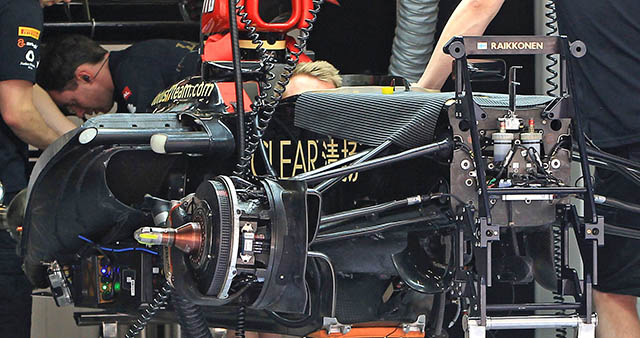
A great a look at the E21 with its bodywork removed, the side impact structures are clear to see with their Rohacell cores.
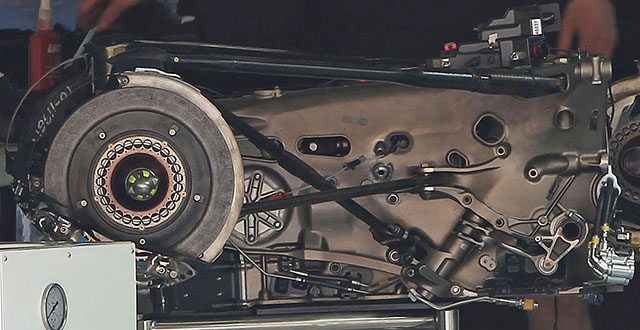
A nice look at the transmission casing of the E21 with the rear suspension and brake assemblies installed.
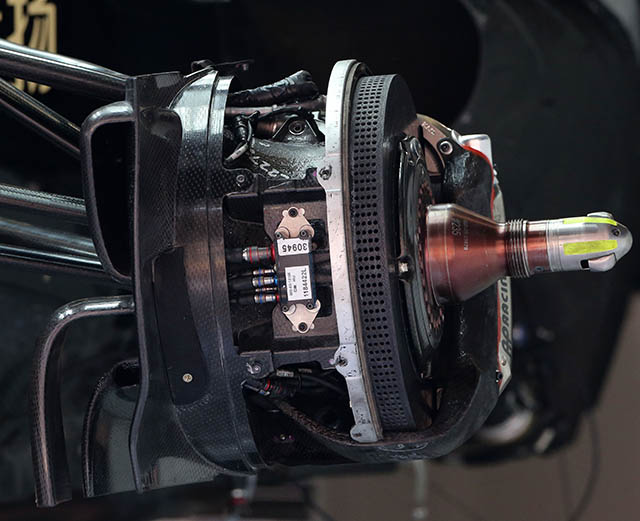
The front hub and brake assembly of the E21 note the apparently blanked off cooling slot.
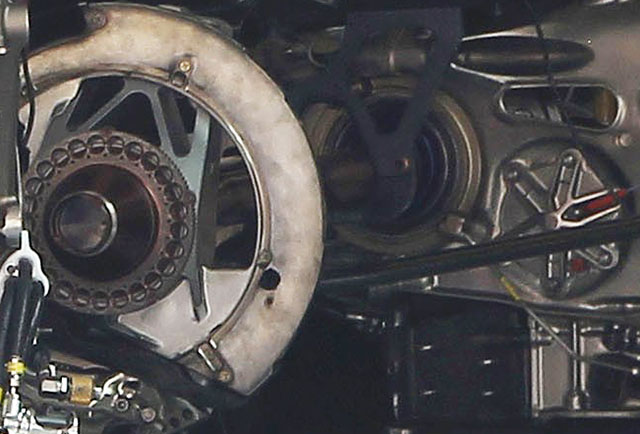
With the brake disc removed some details of the E21’s upright are revealed.

A new sidepod turning vane was fitted to the car with an additional vane on its edge.
RACE 04: SAKHIR, BAHRAIN
Car: 07
Chassis: E21-03
Result: 2nd
Car: 08
Chassis: E21-02
Result: 3rd
Alan Permane, Trackside Operations Director
“Both drivers did a fantastic job today. We know our car is kind on tyres so we were able to play to those strengths and rectify the disappointment of qualifying yesterday. We chose an aggressive strategy with Romain, opting for a three-stop race from eleventh on the grid, and it worked perfectly. He was able to drive aggressively when asked and conserve his tyres when needed, so we are very happy as he delivered everything we wanted from him. With Kimi we used a two-stop strategy and relied on our long run pace. Considering he was suffering from an allergic reaction before he started the race it’s a very impressive performance indeed.”
The E21 seems to be full of itself…
Read more from the December 2012 issue of Racecar Engineering
